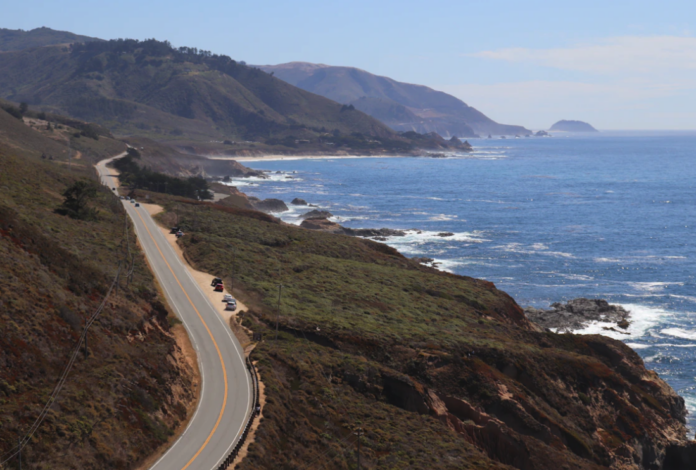A brief history and guide to some of the historical landmarks along the U.S.’s westernmost highway
By SAVANNAH BURGER — arts@theaggie.org
Stretching 656 miles and connecting the coastal redwoods of Northern California to the sandy beaches of Southern California, is SR 1, otherwise known as the California Pacific Coast Highway, the PCH, the Redwood Highway, the Cabrillo Highway, the Shoreline Highway, Highway One or simply just “The One.” It is the longest road in all of California and only second in length in the whole country to Montana Highway 200.
While hugging the cliffs of the coast and bordering on the edge of the Pacific Ocean, Highway One has views that can be captured by no other road. Not only this, but driving on any section of it in California almost guarantees driving past some sort of amazing or interesting historic landmark. Although, it’s important to be careful as it is known to be quite windy and only has two narrow lanes. It’s been that way ever since it’s been built.
Over a hundred years ago in the year of 1919, construction on California’s famous Pacific Coast Highway One began. The most impactful call for the making of the highway came from John L.D. Roberts, M.D. He found that it took hours to reach patients in need who were just up the coast.
As the highway was being constructed, millions of California taxpayer’s dollars funded the completion of the road. The majority of the construction was executed by the prisoners of the San Quentin Rehabilitation Center, then known as San Quentin State Prison, in return for reduced sentences and a whopping 35¢ a day. Many California locals also worked on the highway, with the most notable of them being the famous author of books such as “Of Mice and Men” and “The Grapes of Wrath,” John Steinbeck.
The highway was finally completed in 1937 after millions of cubic yards of rock were blown away with 70,000 pounds worth of dynamite sticks. Limestone was then smelted down and reused for making the concrete of the paved road. 33 bridges also came out of the construction. Although improvements to the road are always ongoing, with the greatest threat to its constitution being landslides, anyone who wants to experience once-in-a-lifetime views and memorable, historical road stops should consider taking a drive.
Highway One has so much to offer in terms of must-see excursions right along the road. Other than access to seemingly endless California beaches, marine wildlife and coastal vegetation as a part of the California Coastal National Monument, the road also boasts close access to a myriad of historical locations and landmarks.
To start off with a few locations from the southern half of the state, Highway One goes right through Huntington Beach. There, you can not only have fun in the sun, but also check out the world’s only international surfing museum, the Huntington Beach International Surfing Museum. While you’re down there, Highway One runs right next to Long Beach’s Queen Mary, the 1930s ocean liner from Scotland turned historic landmark and an allegedly haunted hotel.
Moving north, the road carves through major California cities such as Los Angeles, Malibu and Santa Barbara. In San Luis Obispo, Highway One runs through the famous Pismo Beach. Morro Bay, just north of San Luis Obispo, is also a great stop for the Morro Strand State Beach, Morro Rock Beach and Morro Bay State Park.
San Simeon is also a good place to travel a short distance from the coast to visit the grand Hearst Castle, a historic mansion built between 1919 and 1947 that belonged to the newspaper publisher, William Randolph Hearst.
What’s a Highway One trip without going through Big Sur, enjoying the Point Sur State Historic Park, and driving over the picturesque Bixby Creek Bridge? You’ll cross it on your way to Carmel-by-the-Sea and Monterey Bay. The Monterey Bay Aquarium, one of the world’s most famous aquariums, is a must-see. The highway then runs through Santa Cruz and into the iconic Half-Moon Bay, marking its transition into redwood territory. Be sure to check out the Big Basin Redwoods State Park and Pigeon Point Light Station State Historic Park, which has the tallest lighthouse in California.
Highway One then shoots right through San Francisco, going through the Sunset District, Golden Gate Park, Richmond District and Presidio, the city’s national park. After crossing the Golden Gate Bridge, it traverses to Marin County, home of the breathtaking Golden Gate National Recreation Area and Muir Woods National Monument. Before leaving Marin, make sure to check out Point Reyes National Seashore and visit the Point Reyes Lighthouse for a chance to spy some elephant seals.
In Sonoma County, the road continues through Bodega Bay, the shooting location of Alfred Hitchcock’s infamous film, “The Birds.” The bay is also the home to UC Davis’s Bodega Marin Laboratory. Further up is the Fort Ross State Historic Park, the last Russian settlement in the United States. Just a turn off from the highway, you can walk into all of the buildings in the fort, which are made entirely of redwood.
Beyond Sonoma County, the highway traverses into Mendocino County, which boasts the unique Schooner Gulch State (Bowling Ball) and Glass Beaches. This is the last county Highway One stretches to, and it then ends by joining Highway 101.
If you’re looking for a quality coastal road trip, Highway One is incomparable. Connecting the north and south, all California locals and visitors can head west and take a trip to the coast, breathe in the Pacific air and enjoy the windy, two-lane road that is California’s Pacific Coast Highway.
Written by: Savannah Burger — arts@theaggie.org





